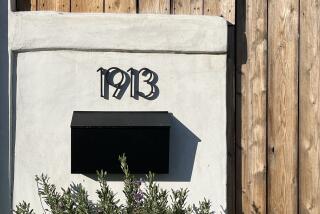The ‘J.R.’ Theory of Tear-Downs
After a lull, the tear-down business is booming again. You can walk along some streets in Santa Monica or Westwood and see so many construction sites that it reminds you of the ‘80s. Or maybe the ‘50s.
Even O.J.’s former house fell to the bulldozer this summer. The investment banker who bought the house found it altogether lacking, the bedrooms too small and the living spaces outdated. O.J. actually agreed with the decision to wreck, saying he would have replaced the house himself if only his bank account had been sizable enough.
In fact, our booming economy has pushed the rate of tearing down and building afresh to its highest level ever, surpassing even the furious ‘80s. In the neighborhoods north of Montana Avenue in Santa Monica, for instance, the tear-down rate has doubled in the past year alone.
But let’s cut to the chase here: Virtually everyone loathes the monolithic structures that rise from the ruins of the older houses except, perhaps, those who live in them. This summer the furor rose to such heights in Santa Monica that the City Council recently spent two nights grappling with ways to change what you might call Tear-Down Style.
The council finally ordered changes that whittled down, to a small degree, the permitted size of the houses. But the basic issue of the awfulness of their design was left untouched. That’s because, as one of the architects in the debate observed, you can’t legislate taste, and the whole debate over tear-downs involves taste.
And so we get to the question for today: Why is Tear-Down Style so ugly?
Or, to put it on a more class-conscious basis: How can people with a million dollars to spend on a house so consistently produce structures that look like decorated mausoleums?
“I can’t tell you why, except that it seems to be an attempt to emulate the style of ‘Citizen Kane,’ ” says Craig Hodgetts, the architect currently building the American Cinematheque theater on Hollywood Boulevard. “They have a tremendous predictability about them. It’s possible that many of the design ideas come from television, what you might call the J.R. style of wealth.”
But what, exactly, is the Tear-Down Style? Usually, though not always, it employs the following:
* Stucco. Wood exteriors apparently violate the first rule of Tear-Down Style.
* Exteriors with Spanish, Italian and “Gone With the Wind” themes. Usually the themes are mixed in a single house. The windows may be “Spanish,” for example, while fake-stone railings are “Italian.”
* At least one front window that reveals a chandelier hanging in the entrance foyer, contributing to the “Gone With the Wind” effect.
* Overall, a look that delivers a clear message. The message is, “Go to hell.”
The architect Jay Charles serves as the chief courtier to the tear-down set in Santa Monica. You might think this would make him a bit defensive, given the scorn directed at some of his designs. But no.
Personally, he says, he prefers small houses. A Craftsman house, say, done in the style of the early 20th century masters Greene and Greene. But his customers want what they want, he says, and he will give it to them. Up to a point.
“Sometimes,” Charles says, “they come in with sketches of a house 200 feet wide. I tell them, ‘But your lot is not 200 feet wide.’ That doesn’t seem to make any difference to them. They still want a house 200 feet wide.’
Charles agrees with Hodgetts’ theory that many of his customers’ design impulses come from the movies and television. A few years back, he says, many of his customers walked in with ideas that seemed to come straight from “Dallas.”
“It was all slick marble, brass, the whole works. Now, though, people seem to be picking up their ideas from their travels. They want something that looks Old World. Usually Mediterranean or French. They’ve seen it on their vacation and want to have the same thing here.”
I ask Charles if his customers really expect an Old World house.
“Of course not,” he says. “You can’t build an Old World house here. It’s virtually impossible. What you can build is a Disneyland version of it, and that seems to be OK with them.”
Actually, the dynamic described by Charles is hardly new in Los Angeles. The wealthy have been stealing ideas from the movies and other places for decades. Just witness the Hansel and Gretel, Disney-inspired houses that dot neighborhoods on the Westside.
Merry Ovnick, the author of “Los Angeles: The End of the Rainbow,” says that idea-stealing goes all the way back to the era of silent movies, when set designers employed a technique known as “compacted style reference.”
If the designers were building a castle set, say, they would cram all sorts of castle features onto the facade. Turrets, drawbridges and the like would be jammed together so the moviegoer would immediately recognize the structure as a castle.
‘Well,” Ovnick says, “soon people were building homes in Los Angeles that looked like castles and used the compacted style. Perhaps it was done subconsciously, but you can still see these houses around the city.”
And, as a matter of fact, we often regard those houses today as part of the intriguing architectural history of the city. Is it possible that the Tear-Down Style will one day seem the same?
We can only wait and see. In the meantime, Charles says his office alone is designing tear-down houses at the rate of 40 a year. Some in Spanish, some in French, some in Italian, some in a combination of all.
It is, he says, what his customers want.






